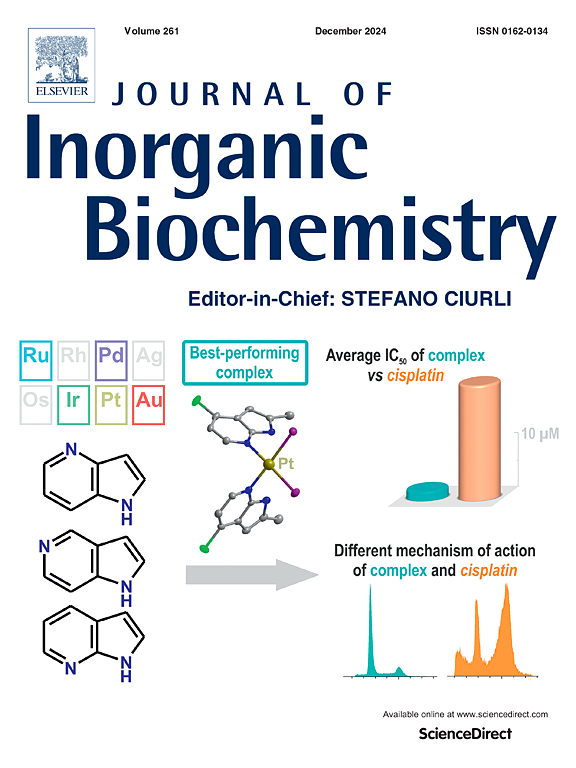Cyclometalated iridium(III)-lonidamine conjugates: Mitochondrial targeting and pyroptosis induction
IF 3.2
2区 化学
Q2 BIOCHEMISTRY & MOLECULAR BIOLOGY
引用次数: 0
Abstract
A series of cyclometalated Ir(III)-lonidamine (LND) complexes (Ir-LND-1–6) with the formula [Ir(C^N)2bpy(4-CH3–4’-CH2OLND)](PF6) (Ir-LND-1–3) and [Ir(C^N)2bpy(4-CH2OLND-4’-CH2OLND)](PF6) (Ir-LND-4–6) (C^N = 2-phenylpyridine (ppy, in Ir-LND-1 and Ir-LND-4), 2-(2-thienyl) pyridine (thpy, in Ir-LND-2 and Ir-LND-5) and 2-(2,4-difluorophenyl) pyridine (dfppy, in Ir-LND-3 and Ir-LND-6)), were designed and synthesized. 3-(4,5-dimethylthiazol-2-yl)-2,5-biphenyltetrazolium bromide (MTT) assay data showed that the cytotoxicity of Ir-LND-1–3 carry one LND moiety was superior to that of Ir-LND-4–6 with two LND moieties. Therefore, we selected Ir-LND-1–3 as model compounds to investigate the anti-tumor mechanism of the Ir(III)-LND system. The results showed that Ir-LND-1–3 could inhibit cancer cell migration and colony formation. In addition, Ir-LND-1–3 could penetrate into HeLa cells and localized to mitochondria, further disrupting mitochondrial membrane potential (MMP), increasing intracellular reactive oxygen species (ROS), and reducing intracellular adenosine triphosphate (ATP). Further exploration of anti-tumor mechanisms showed that pyroptosis was the main mode of Ir-LND-1–3 induced cell death, manifested as membrane perforation and swelling, activation of caspase-3 and cleavage of Gasdermin E (GSDME), as well as release of lactic dehydrogenase (LDH) and ATP. The pyroptosis induced by Ir-LND-1–3 also initiated immunogenic cell death (ICD) by triggering the release of calreticulin (CRT) and high mobility group protein b1 (HMGB1) on the cell surface.

环金属化铱(III)-lonidamine偶联物:线粒体靶向和焦亡诱导
设计并合成了一系列环金属化Ir(III)-lonidamine (LND)配合物(Ir- ln1 -6),分子式为[Ir(C^N)2bpy(4-CH3-4′- ch2olnd)](PF6) (Ir- ln1 -3)和[Ir(C^N)2bpy(4-CH2OLND-4′- ch2olnd)](PF6) (Ir- ln4 -4) (C^N = 2-苯基吡啶(py,在Ir- ln1和Ir- ln4中),2-(2-噻吩基)吡啶(py,在Ir- ln2 - ln2和Ir- ln5中)和2-(2,4-二氟苯基)吡啶(dppy,在Ir- ln3和Ir- ln6中))。3-(4,5-二甲基噻唑-2-基)-2,5-联苯基溴化四唑(MTT)试验数据表明,携带1个LND片段的Ir-LND-1-3的细胞毒性优于携带2个LND片段的Ir-LND-4-6。因此,我们选择Ir-LND-1 - 3作为模型化合物,研究Ir(III)-LND体系的抗肿瘤机制。结果表明,Ir-LND-1-3能够抑制癌细胞的迁移和集落形成。此外,Ir-LND-1-3可以渗透到HeLa细胞并定位到线粒体,进一步破坏线粒体膜电位(MMP),增加细胞内活性氧(ROS),减少细胞内三磷酸腺苷(ATP)。进一步的抗肿瘤机制探索表明,Ir-LND-1-3诱导细胞死亡的主要方式是焦亡,表现为膜穿孔肿胀、caspase-3的激活和Gasdermin E (GSDME)的裂解,以及乳酸脱氢酶(LDH)和ATP的释放。ir - nd -1 - 3诱导的焦亡也通过触发钙网蛋白(CRT)和高迁移率组蛋白b1 (HMGB1)在细胞表面的释放而引发免疫原性细胞死亡(ICD)。
本文章由计算机程序翻译,如有差异,请以英文原文为准。
求助全文
约1分钟内获得全文
求助全文
来源期刊

Journal of Inorganic Biochemistry
生物-生化与分子生物学
CiteScore
7.00
自引率
10.30%
发文量
336
审稿时长
41 days
期刊介绍:
The Journal of Inorganic Biochemistry is an established international forum for research in all aspects of Biological Inorganic Chemistry. Original papers of a high scientific level are published in the form of Articles (full length papers), Short Communications, Focused Reviews and Bioinorganic Methods. Topics include: the chemistry, structure and function of metalloenzymes; the interaction of inorganic ions and molecules with proteins and nucleic acids; the synthesis and properties of coordination complexes of biological interest including both structural and functional model systems; the function of metal- containing systems in the regulation of gene expression; the role of metals in medicine; the application of spectroscopic methods to determine the structure of metallobiomolecules; the preparation and characterization of metal-based biomaterials; and related systems. The emphasis of the Journal is on the structure and mechanism of action of metallobiomolecules.
 求助内容:
求助内容: 应助结果提醒方式:
应助结果提醒方式:


